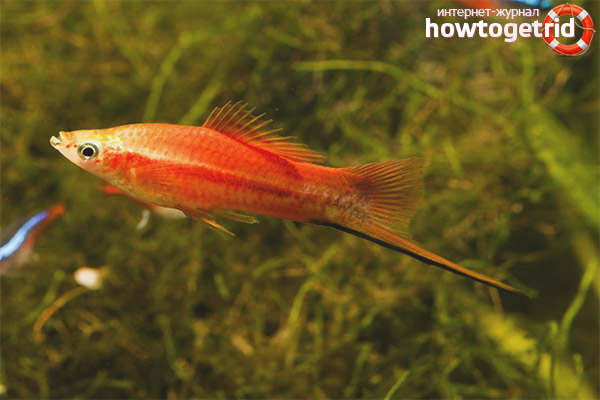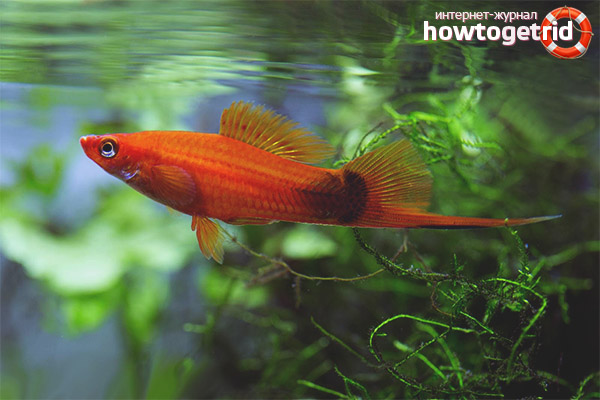The content of the article
Swordsman is a rather famous species of scaly, which got its bright name due to the presence of a special outgrowth on the fin. In outward appearance, this outgrowth resembles a sword, which is why fish began to be called that. They began to contain representatives of this species in aquariums in the 19th century, and since then they have not lost their popularity. The Swordsman is mainly loved for their interesting appearance and variety of colors. In addition, such fish are not too demanding on the conditions of detention and quickly bring offspring.
Swordfish are peace-loving fish that easily get along with representatives of other species, so they are often placed in shared aquariums. However, it is important to remember that these are individuals with different characters. Therefore, you can meet peaceful and quiet representatives, or you can buy a bully and a badass. This is especially true for males, as they usually behave more aggressively.
It is best to place the swordsmen in a large spacious aquarium in which there will be enough space for swimming, and, at the same time, there will be a variety of plants. A good option would be a bone with floating plants. Such inclusions will serve as a tool for scattering light, which is very good for fry, as they will have shelter. Like most live-bearing fish, swordsmen are adapted to live in salt water, but this is not a requirement.
Life in the wild
The native places for the swordsmen are the territories in Central America, located from the southern part of Mexico to Guatemala. In the reservoirs of these places you can find the original swordsmen, whose color is less bright than those that have already been bred in aquariums.
In natural conditions, the sword-bearer can be found in a variety of reservoirs; they live both in stagnant water and in flowing water. As a rule, fish of this species choose places that are well overgrown with plants for life. Here they have enough food in the form of algae, various insects and detritus.
View description
In general, there are quite large varieties of swordsmen. Males of this species can grow up to 11 centimeters in length, and females even up to 12. Fish of this size reach their natural habitat. In an aquarium, they are usually a little smaller. The average life expectancy of such individuals is 4 years.
As for the outer pitchfork and color, in this case it is difficult to distinguish a certain group of colors, since the swordsmen are very diverse. The most popular are red fish with a black tail in the form of a sword. Black, green, yellow, spotted fish and even albinos are also found. Describing their appearance is quite difficult, but almost everyone knows what a swordsman looks like if he has ever seen an aquarium at least once in his life. So these individuals are common today.
Aquarium Requirements
Swordsman - this is perhaps the most common type of fish among aquarists who are just starting their journey in breeding scaly. These fish are easy to maintain, as they are small, not too whimsical and demanding on the conditions provided, and, moreover, are very easy to breed. Among the shortcomings of this species, one can distinguish the bullying and pugnacity of some male sword-bearers.
How to feed the swordsmen?
Swordfish are almost omnivorous fish.They can be treated with frozen food, cereal, live food and other varieties of feed from the pet store. Like all representatives of scaly, they need a special diet, which will include a variety of foods. It is very important that in the diet of these fish there are plant foods with a large amount of fiber in the composition.
Under natural conditions, Swordsmen consume a large number of thin algae and other fragile plants and fouling. It will be impossible to place the same large amount of algae in the aquarium, and it is extremely inconvenient, so you can use ready-made cereals made from plants as a substitute. You can even put such flakes in the basis of the menu, and make live feeds just an addition to food. Swordsmen can be supplied with any live food, in this regard, fish of this species are not demanding.
What care is required?
Swordsmen are very unpretentious representatives of fish, so keeping them is quite simple. For one fish, a capacity of 35 liters will be enough. However, it is worth noting that these are active fish, so if there is an opportunity to buy an aquarium more, it will not be superfluous. It is also important to remember that if you have a goal of breeding fish, you should put one male in one aquarium, and two or three females to it. If you take only one female, then the male can simply drive her or even bring her to death.
It is better not to plant several males in one aquarium, since swordfish always have a strict separation. For this reason, one of the males will pull the blanket over himself and chase the other males, which will inevitably lead to conflicts, skirmishes, fights and, as a result, injuries.
Swordsmen are not particularly demanding on the temperature of the water in the aquarium. They are able to survive at 18 degrees, as well as at 28. The most suitable temperature is from 23 to 25 degrees. Water hardness and acidity also do not greatly concern swordsmen, however, water of medium hardness and a pH in the range from 6.8 to 7.8 are the most acceptable option.
It is advisable to install filtration equipment in the aquarium with swordsmen. It will be enough to use an internal filter. It is also very important to replace water with fresh water every week, about one fifth of the total volume. It is also necessary to take into account that the swordsmen are good jumpers, therefore you should definitely cover the aquarium with something, otherwise, if you do not have people at home, you risk finding somewhere a dried fish corpse.
You can decorate the aquarium as you like, here everything depends on your preferences. The only thing, experts often recommend using plants as decorations. You can plant them quite densely, since the swordsmen are very fond of such a habitat. In addition, dense thickets allow females to hide from the aggressive behavior of males.
Who can the swordsmen be with?

Elderly male swordsmen are able to show aggression and even attack representatives of other fish species. However, this behavior is individual. Some swordsmen indeed become violent with age and periodically arrange fights in the aquarium, while some individuals, on the contrary, become quiet and calm. Increased aggression in males contribute to aquariums without plants. Absolutely definitely should not settle in the neighborhood of two or three males, if you do not want to observe constant skirmishes.
Swordsmen normally coexist with other viviparous fish, which include guppies, mollies, and pecilia. Swordsmen also coexist quite well with fish spawning, namely with iris, scalaria, neon and goura. It is better not to place goldfish near the swordsmen, since they require lower temperature water, and swordsmen are generally quite restless neighbors for goldfish.
How to distinguish between males and females?
Quite often there are cases when a female turns into a male, having grown a sword on her fin. The most interesting thing is that the female’s behavior also changes, she begins to behave as a representative of the stronger half and even cares for other females, however, she is barren. Today, the reasons for this unusual phenomenon have not yet been clarified.
How does reproduction occur?
Swordfish are fish belonging to live-bearers, therefore, the process of fertilization of eggs takes place inside the body of the female, where she hatches eggs until the fry is fully formed. After this, childbirth occurs and ready-made live fry appear. The gestation period lasts about a month.
Video: aquarium fish swordsman











Submit